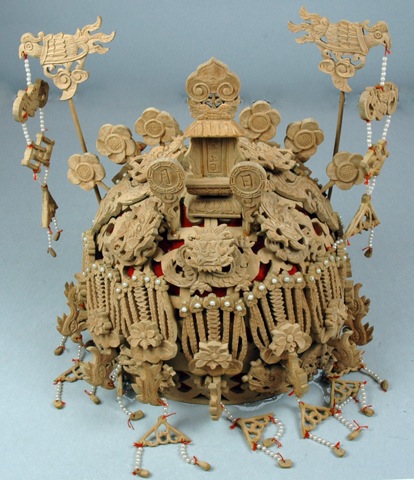Burial headdress
China, Manchu, 1920s
 Donated by Mrs C. de Beauvoir Stocks in 1926; 1926.29.1 .1After the Manchu (Qing) rulers took control of China in 1644, they blended their own funerary customs with those of the Han Chinese. For example, the Manchus abandoned their ancient custom of cremation in favour of burial, and eventually forbade widow suicide. However, the Manchus decreed that some of their customs remain, such as men cutting their 'queues' (long plaits of hair) as a sign of mourning and the requirement to carry the coffin in and out of the house through the window as they believed doors should only be used by the living.
Donated by Mrs C. de Beauvoir Stocks in 1926; 1926.29.1 .1After the Manchu (Qing) rulers took control of China in 1644, they blended their own funerary customs with those of the Han Chinese. For example, the Manchus abandoned their ancient custom of cremation in favour of burial, and eventually forbade widow suicide. However, the Manchus decreed that some of their customs remain, such as men cutting their 'queues' (long plaits of hair) as a sign of mourning and the requirement to carry the coffin in and out of the house through the window as they believed doors should only be used by the living.
The funerary ceremonies of members of the imperial household were elaborate and complex. After the cultural revolution of 1911 there was an influx of western ideas into China, but old burial ceremony of the Manchu regime was still carried out for a time. This wooden helmet-shaped headdress, lined with red cloth and decorated with ornate fretwork and pearl-bead pendants, was part of a complete burial outfit for the deceased wife of a civil servant (bannerman) of the second rank. Other items in the outfit comprise a belt, earrings, hair ornaments, rings, and bracelets all carved out of wood in a similar style. They was obtained from a shop, probably in Beijing, where a such an outfit was always kept in stock in readiness for any sudden demand for it, although it could only be used with the permission of the Emperor.
In earlier times in China, possessions were burnt as offerings to the gods or the dead. In Imperial funerals real clothing and furniture continued to be burned in great quantities but among the bannermen paper objects came to be used instead. Today in China and Thailand, there is a flourishing industry that creates and sells paper and papier-mâché items that the bereaved can offer to the dead. These might represent things that the deceased used or coveted in life, or which may be of help to them in the afterlife. Paper offerings include replica money, mobile phones, flowers and even full-size cars, which are burnt as part of the funeral ceremony to ensure they reach the person in the next world.
